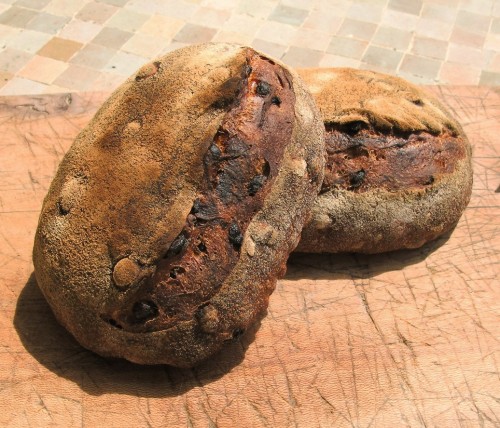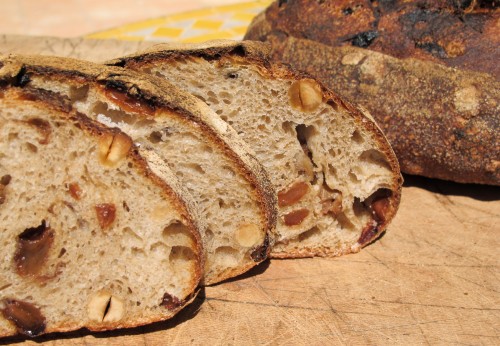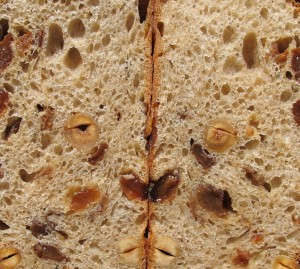 I know….I am getting a little carried away here but… when I looked back at the notes I took when making the bread it did not resemble the original recipe for the Pain Poilâne at all. When it all is said and done….pain/bread is just water, flour and salt in different combinations to achieve the desired taste and texture. I have to be very honest with you here, I have been a strictly “bake by the book” kind of guy for the last decade…and it feels good to reach this turning point. When I do go astray and mess up a loaf or two, I will remember a quote I came across by Max Poilâne about breads and pastry.
I know….I am getting a little carried away here but… when I looked back at the notes I took when making the bread it did not resemble the original recipe for the Pain Poilâne at all. When it all is said and done….pain/bread is just water, flour and salt in different combinations to achieve the desired taste and texture. I have to be very honest with you here, I have been a strictly “bake by the book” kind of guy for the last decade…and it feels good to reach this turning point. When I do go astray and mess up a loaf or two, I will remember a quote I came across by Max Poilâne about breads and pastry.
“The best bread I ever tasted was one that didn’t work….it fermented too long and it was full of holes like Gruyere. But, oh, what a taste. Bread unlike pasterine, is very forgiving. You can make mistakes and still end up with a bread that tastes good….”
I am glad to say that this bread worked out perfectly and met with all my expectations. The addition of the whole-wheat flours gives the crumb an earthy taste and the sweetness of the raisins and nuts all work together to make a bread good to eat any time of the day. My favorite way to eat this bread is toasted with a dab of butter and homemade apricot confiture… but, I was surprise that it even worked with my favorite lunch, a smear of soft goat cheese (the closest thing I can find to cream cheese in France), capers and smoked salmon.
Pain Poilâne “Jude” with raisins and hazelnuts
(Jude is what the people in town call me, they have a hard time with Judd)
Loosely Adapted from Daniel Leader’s Local Breads
Desired dough temperature 76°
Levain Starter:
- 50 g stiff Levain starter
- 100g stone-ground whole wheat flour
- 75 g water
Ingredients:
- 200 g Type 80 flour (82-85% extraction)
- 300 g Type 110 flour (85-90% extraction)
- 30 g La farine de gluten (optional, the French flour tends not be so strong)
- 375 g water
- 225 g stiff whole wheat Levain
- 10 g salt
- 150g Hazelnuts (or walnuts), roasted and skinned(see below)
- 230g raisins(use golden raisins if you have them)
Bread method:
- Take your levain out of the refrigerator, weigh out the appropriate amount of starter and mash the levain with a whisk in a bowl with the water. Add the flour and stir with a spatula until it comes together. Turned out onto the work surface and knead to incorporate the flours. Place the Levain in a covered container and let it sit at room temperature (70 to 76°) for 8-12 hours or until it has doubled in volume and the surface is domed.
- Soak the raisins in warm water for an hour and then blot dry. The hazelnuts should be thoroughly roasted before using. Place the whole nuts on a sheet pan and bake at 350 to 400° for 8 to 12 minutes. The nuts will not roast further once incorporated in the bread so make sure they are nicely brown. Once the nuts are cool enough to handle, rub them between your hands and the skin should come off easily.
- Pour the water into a large mixing bowl or the bowl stand mixer. Combine the flours until all the ingredients are incorporated. Cover and let it rest for 20 minutes, while the flour hydrates and the gluten begins to develop. (I could not fit my Kitchen Aid Pro in my suitcase, so I mix by hand… I autolyse/rest for one hour before adding the Levain, which really helps the gluten development)
- Kneading By hand: Turn the dough out onto your work surface. I flatten the dough into a large rectangle; smear the Levain on top of the dough. With floured or oiled hands knead a few strokes to fully incorporate the starter, flatten out the dough, evenly disperse the salt and continue kneading for 12 to 15 minutes. I use a combination of the French kneading technique and this method if the dough is really wet to start. For the first couple of minutes it will be a sticky mess on your work surface, but do not yield to the temptation of adding more flour. Stop occasionally and use your bench scraper to gather any stray dough off of your work surface. Continue until you have a good gluten development. You should be able to gently stretch a piece of the dough into a thin membrane that you can almost see through without it tearing. Again, flatten the dough into a large rectangle and gently knead in the nuts and raisins till evenly distributed. By machine: Add the salt and Levain and mix the medium speed until the dough cleans up the bowl and you reach a good gluten development. Add the nuts and raisins.
- Transfer of the dough to a lightly oiled container. Cover and let it ferment at room temperature for one hour (70 to 75°). (I keep the dough at a consistent temperature 76° throughout.) If you would like to get a good overall picture of the bread making process for the home baker, I highly recommend you check out Mark’s videos at the Back Home Bakery
- Turn the dough out onto your lightly floured work surface, fold the dough and return it to oiled bowl with folds on the bottom and cover. Let the dough ferment for 2 to 3 hours more. You can incorporate another fold after 50 minutes if you’re dough does not seem to have strength.
- You can make on big miche with all the dough. I divided it into two pieces, pre-shape into a log. Lightly flour the dough, cover and let rest for 10-15 minutes to relax the dough.
- Shape each piece of dough into a oval loaf or batard and place seam side up on a floured couche or into floured bannetons. Cover with a plastic bag or plastic wrap and proof at room temperature for one hour. (76°)
- About one hour before baking, preheat the oven to 500° with baking stone and a tray in the bottom of the oven for steam. I like to add one cup of water baking or one cup of ice cubes to the bottom tray a few minutes before putting the loaves in the oven for to produce a moist environment for the baking of the proofed loaves.
- Gently turn the proofed loaves onto parchment paper or your floured peel and score. Slide the loaves onto the baking stone, turn down the oven to 470° and continue to bake for 20 to 25 minutes. (I turn the oven down to 450° and then after 20 minutes, rotate them to get an even distribution of the heat.)If you are baking one big loaf,bake until the crust is walnut brown. For a good crust you want a bold bake, when you tap the bottom of the loaf you should hear a hollow thud (that is a technical term).
- Let cool on a wire rack before digging in. This bread gets better with age and will stay fresh up to a week.
This is being sent to YeastSpotting








Hey Jude, nice bread! I also like that Poilane quote — how true!
Thanks Susan…I am really liking the Poilane bread with 30% spelt! I will have to post it when I get back from my trip to Corsica. In a big miche it stays really fresh for days. I recently gave half of 2.5 kilo miche to the local Shepard. I saw him the day after and asked what do you think…he said “it is too fresh to eat…he will wait a couple of days” 🙂
Hey Judd, that bread looks beautiful…. You’ve gone all “gram-ie” on us!!
Bravo, Jude! Your bread looks delicious and Iove it that you allowed yourself to let go of the books… Liberating, isn’t it?
The bread looks so good! And changing recipes is so much fun.
I never can stick to recipes, my mom always tells me that I should only mention if I would not change anything.
Thanks Stefanie…I have a real soft spot for raisins and nut in bread!
Mc…You can be assured that i am not going to get rid of my books as of yet… 😉